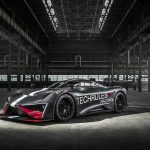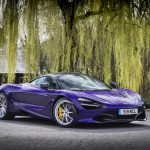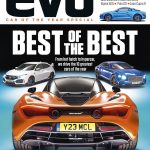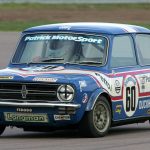A saloon with a sporty heart
With almost a million people visiting dealerships on the first “open doors” Sunday, over 100,000 orders placed in just a few months and 680,000 total sales between 1997 and 2005, the Alfa Romeo 156 one of the most successful models in the brand’s history.
The 156 was presented to the international press in 1997 at the Centro Cultural de Belém, Lisbon. The company’s intentions were clearly declared: to create a saloon that combined style and impeccable dynamic behavior, with a perfect balance between performance and handling. A 100 per cent Alfa Romeo product formula. The goal was highly ambitious and resulted in one of the best front-wheel drive cars ever.
Alfa Romeo and front-wheel drive
While the first ever cars were built with rear-wheel drives the idea of front-wheel drive appeared in Alfa Romeo minds in the first post-war period. Satta Puliga and Busso had been convinced of the potential of this solution and started a development program that aimed to make the 1900 the brand’s first front-wheel drive car.
However, the company decided to head in a different direction and at the beginning of the 1950s, the idea of creating a smaller front-wheel drive Alfa Romeo was considered. None of these projects reached the industrialisation phase, but Alfa Romeo decided to extend its range with a compact model below the Giulietta.
The new project was entrusted to Rudolf Hruska, the ‘father’ of the various Giulietta versions. He was commissioned to design both the new car and the factory where it would by built. The first Alfa Romeo front-wheel drive model, the Alfasud, was born.
As the factory was designed specifically to build the Alfasud, the car had no technical constraints to respect, apart from being faithful to its product objectives. “It obviously had to be a front-wheel drive. And it had to be a luxury subcompact, a 5-seater car with a very large trunk” Hruska described the project a few years later.
The 1.2 litre “boxer” engine is preferred to the 4-cylinder in-line, because it is lower and allows for a more aerodynamic profile. The “two-volume” body was created to improve access to the boot which had a 400 litre capacity, thanks to the fuel tank being set under the rear seats. This made for an innovative, functional and safe approach which was widely imitated.
The Alfasud was the first important order taken on by Giorgetto Giugiaro and proved to be a huge commercial success. To respect all the constraints of space and size, the young stylist invented the characteristic “high tail” and connected it to the aerodynamic front through a simple streamlined line.
Alfasud went into production in 1972, the year when Alfa Romeo production exceeded one million units since its foundation. By itself, the Alfasud almost equalled this record with 900,925 units produced between 1972 and 1984 (not to mention the Sprint versions). It became the best selling Alfa Romeo ever.
From production rationalisation to brand centrality
In 1986, the state owner of Alfa Romeo since 1933, IRI, sold the brand to the Fiat Group. As in all industrial integration processes, the first years were devoted mainly to the rationalisation of production and supply chains.
In the 1980s, the watchword for all carmakers was “synergies”. Process and product were increasingly standardised, many components were shared for cost reasons and designers were obliged to respect rigid constraints which smothered creativity. In the following years, these rules were loosened as customers disliked the excessive homologation and began looking for more identifiable cars. The personality of the brand returned, and this turning point changed the history of turn-of-the-century car design.
Sporty driving, high performance, innovation and style
For Alfa Romeo, this meant a return to its origins. The first big step to relaunch the distinctive characteristics of the brand was to revive Alfa Corse, the racing team where the young Enzo Ferrari had taken his first steps. In 1993, the 155 GTA participated in the Deutsche Tourenwagen Masters (DTM) championship in Germany, driven by Nicola Larini who won by finishing first in 11 out of 20 races and carrying Alfa Romeo to the top step of the Nürburgring podium for the first time.
The contribution of design was paramount. The 164 of 1987, the brand’s first front-wheel drive flagship, was designed by Pininfarina, but from that moment on, the role of the internal Centro Stile Alfa Romeo became increasingly important.
In Arese, technologies changed, people changed and processes changed. The Centro Stile team integrated new computer-assisted systems for design and prototyping and worked closely with the technical teams too – after all, what is functional must also be beautiful and vice versa. Form and substance always go together, that is the “necessary beauty” of Alfa Romeo.
Designing a new range
The Centro Stile created not only the style of a model, it designed a complete range. In 1995 the brand brought an original two-volume model to the “C” segment, the 145, and the following year this was joined by the two-and-a-half-volume version, the 146. The GTV and Spider sports cars followed, created in collaboration with Pininfarina, but the real turning point came with the 156.
The style of the 156 was an extraordinary mix of strength, innovation and classicism. The front shield reclaimed its dominance and projected its lines onto the bonnet. Seen from the front, the mudguards seemed “clamped on the wheels” flush with the bodywork, radiating strength and road grip. The relationship between glass and metal surfaces resembled a coupe more than a saloon. The rear door handles disappeared, integrated almost invisibly with the window frames and the clean flanks highlighted the car’s sleek and dynamic profile. “It seems to be moving even when it’s still,” commented Italian car designer Walter de Silva.
The 156 returned to the kind of use of colour previously glimpsed in the Carabo and the Montreal. The Alfa Romeo designers found inspiration in the Museum collection, observing the colour of the 8C 2900 B of 1938 they invented “Nuvola” blue, obtained with a multiple layer mica effect that gave the car an iridescent glint.
Advanced sportiness
The 156 was an astonishing car from a technical point of view too. The designers had been asked to develop the concept of “advanced sportiness” by combining power, lightness and control. This has always been the formula expressing Alfa Romeo driving.
To achieve this goal, new materials such as magnesium and “tailored blank” steels were introduced, highly refined suspension systems were designed and particular care was devoted to mechanical tuning in order to enhance handling performance and trajectory precision.
The 156 convinced everyone that it was the most thrilling saloon to drive of its entire generation. The sporting version was a winner as in 10 years of Gran Turismo championships it won 13 titles.
The birth of the “common rail”
At launch there were six engines. The Busso V6 was accompanied by three “Twin Spark” engines which, for the first time, combined double ignition (a technology previously used by Giuseppe Merosi in 1914) with four valves per cylinder.
According to the logic of the European market at the time, petrol was the prevailing fuel. These rules were about to change and it was Alfa Romeo who launched the revolution with the 156, the first car in the world to launch the “common rail” system.
Journalists testing the 1.9-litre and 2.4-litre JTD versions in Lisbon were amazed and for the first time, diesel engines were offering petrol-level performance, silencing and comfort.
“Car of the Year”
The 156 won the hearts of public and critics, and in 1998 delivered the international “Car of the Year” award to Alfa Romeo for the very first time. Its younger sister, the 147, which shared not only the stylistic “family feeling” but also the base, suspension and engines, followed up a few years later, winning the same award in 2001.





















